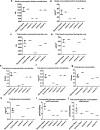Benchmarking of Scale-X Bioreactor System in Lentiviral and Adenoviral Vector Production
- PMID: 32075423
- PMCID: PMC7087403
- DOI: 10.1089/hum.2019.247
Benchmarking of Scale-X Bioreactor System in Lentiviral and Adenoviral Vector Production
Abstract
We have previously produced viral vectors (lentiviral vector, adenoviral vector, and adeno-associated viral vector) in small and in commercial scale in adherent cells using Pall fixed-bed iCELLis® bioreactor. Recently, a company called Univercells has launched a new fixed-bed bioreactor with the same cell growth surface matrix material, but with different fixed-bed structure than is used in iCELLis bioreactor. We sought to compare the new scale-X™ hydro bioreactor (2.4 m2) and iCELLis Nano system (2.67 m2) to see if the difference has any effect on cell growth or lentiviral vector and adenoviral vector productivity. Runs were performed using parameters optimized for viral vector production in iCELLis Nano bioreactor. Cell growth was monitored by counting nuclei, as well as by following glucose consumption and lactate production. In both bioreactor systems, cells grew well, and the cell distribution was found quite homogeneous in scale-X bioreactor. Univercells scale-X bioreactor was proven to be at least equally efficient or even improved in both lentiviral vector and adenoviral vector production. Based on the results, the same protocol and parameters used in viral vector production in iCELLis bioreactor can also be successfully used for the production in scale-X bioreactor system.
Keywords: bioreactor; fixed-bed; iCELLis bioreactor; lentivirus; scale-X bioreactor; virus production.
Conflict of interest statement
H.M.L., S.L., E.M.L., and H.P.L. are employees of Kuopio Center for Gene and Cell Therapy, and Finvector. No competing financial interests exist for T.H., T.K., N.P., and S.Y.-H.
Figures




Similar articles
-
Lentiviral Vector Bioprocessing.Viruses. 2021 Feb 9;13(2):268. doi: 10.3390/v13020268. Viruses. 2021. PMID: 33572347 Free PMC article. Review.
-
Process Development of Adenoviral Vector Production in Fixed Bed Bioreactor: From Bench to Commercial Scale.Hum Gene Ther. 2015 Aug;26(8):560-71. doi: 10.1089/hum.2015.081. Hum Gene Ther. 2015. PMID: 26176404
-
Optimization of lentiviral vector production for scale-up in fixed-bed bioreactor.Gene Ther. 2018 Jan;25(1):39-46. doi: 10.1038/gt.2017.91. Epub 2017 Oct 5. Gene Ther. 2018. PMID: 29345252 Free PMC article.
-
Development and Optimization of AAV hFIX Particles by Transient Transfection in an iCELLis(®) Fixed-Bed Bioreactor.Hum Gene Ther Methods. 2016 Jun;27(3):112-21. doi: 10.1089/hgtb.2016.021. Hum Gene Ther Methods. 2016. PMID: 27229773
-
Evaluation of the Single-Use Fixed-Bed Bioreactors in Scalable Virus Production.Biotechnol J. 2021 Jan;16(1):e2000020. doi: 10.1002/biot.202000020. Epub 2020 Oct 12. Biotechnol J. 2021. PMID: 32971565 Review.
Cited by
-
Slow and steady wins the race: Optimizing lentiviral vector production for efficient clinical-scale manufacturing.Mol Ther Methods Clin Dev. 2023 Aug 29;30:484-485. doi: 10.1016/j.omtm.2023.08.011. eCollection 2023 Sep 14. Mol Ther Methods Clin Dev. 2023. PMID: 37681060 Free PMC article. No abstract available.
-
Large-Scale Production of Lentiviral Vectors: Current Perspectives and Challenges.Pharmaceutics. 2020 Nov 3;12(11):1051. doi: 10.3390/pharmaceutics12111051. Pharmaceutics. 2020. PMID: 33153183 Free PMC article. Review.
-
Sabin inactivated polio vaccine upstream process development using fixed-bed bioreactor technology.Vaccine. 2025 Apr 19;53:126950. doi: 10.1016/j.vaccine.2025.126950. Epub 2025 Mar 3. Vaccine. 2025. PMID: 40037128 Free PMC article.
-
Aggregating in vitro-grown adipocytes to produce macroscale cell-cultured fat tissue with tunable lipid compositions for food applications.Elife. 2023 Apr 4;12:e82120. doi: 10.7554/eLife.82120. Elife. 2023. PMID: 37014056 Free PMC article.
-
Lentiviral Vector Bioprocessing.Viruses. 2021 Feb 9;13(2):268. doi: 10.3390/v13020268. Viruses. 2021. PMID: 33572347 Free PMC article. Review.
References
-
- Masri F, Cheeseman E, Ansorge S. Viral vector manufacturing: how to address current and future demands? Cell Gene Ther Insights 2019;5:949–970
-
- Lesch HP, Heikkilä KM, Lipponen EM, et al. . Process development of adenoviral vector production in fixed bed bioreactor: from bench to commercial scale. Hum Gene Ther 2015;26:560–571 - PubMed
-
- Galibert L, Chafqane A, Nieminen T, et al. . Optimizing the production of recombinant AAV vector encoding VEGF-B in iCELLis bioreactors. In: 22nd ASGCT Annual Meeting. Washington, DC, 2019. https://www.asgct.org/global/documents/asgct19_abstracts_-final (last accessed November19, 2019)
Publication types
MeSH terms
LinkOut - more resources
Full Text Sources
Other Literature Sources
